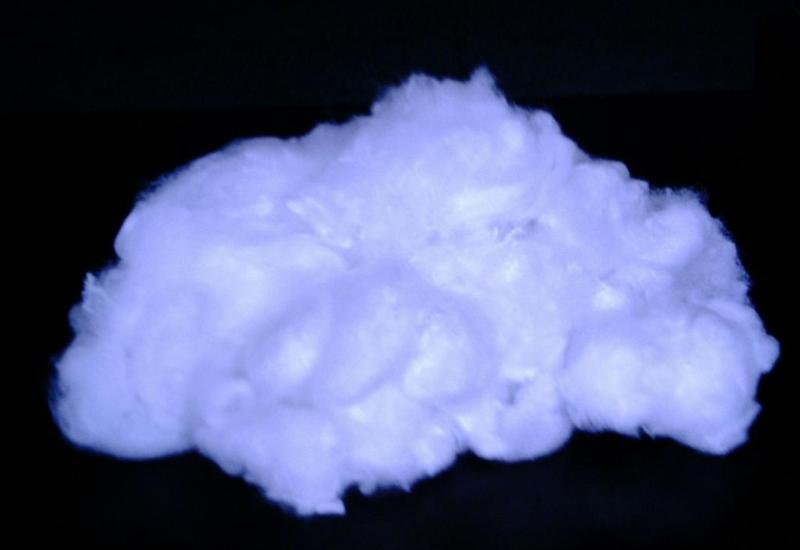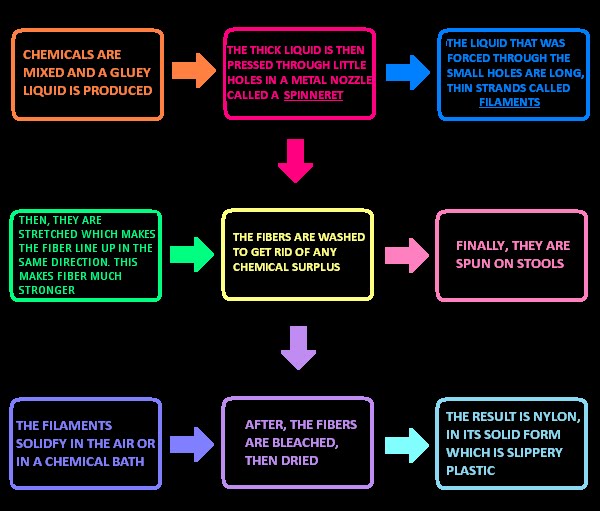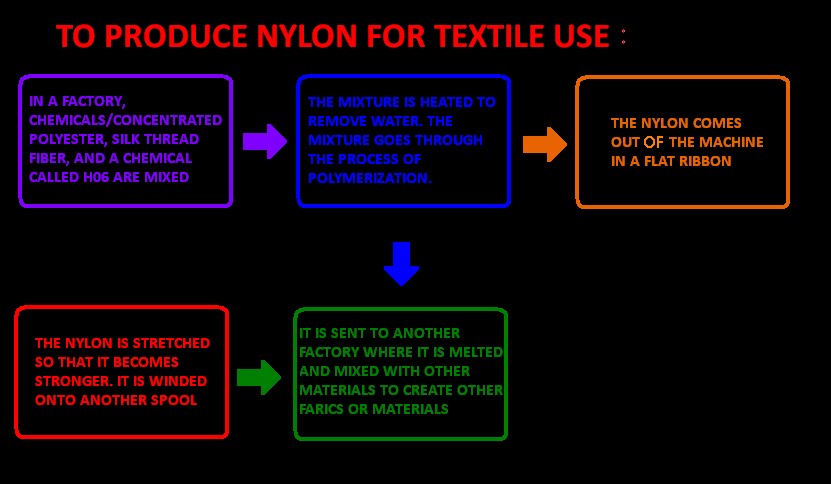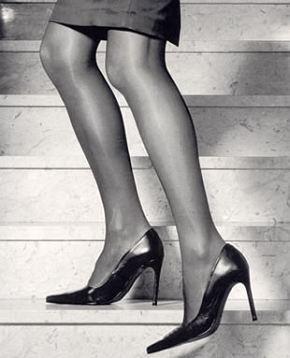Works Cited List!
2. Adshead, J. (2009). Nylon. Grolier Multimedia Encyclopedia. Retrieved November 26, 2009, from Grolier Online http://gme.grolier.com/cgi-bin/article?
3. Fernandez, J. E. (2009). Polymerization. Grolier Multimedia Encyclopedia. Retrieved November 26, 2009, from Grolier Online http://gme.grolier.com/cgi-bin/article?assetid=0232210-0
4. Adshead, J. (2009). Synthetic fibers. Grolier Multimedia Encyclopedia. Retrieved November 26, 2009, from Grolier Online http://gme.grolier.com/cgi-bin/article?assetid=0282400-0
5. Adshead, J. (2009). Nylon. Grolier Multimedia Encyclopedia. Retrieved December 1, 2009, from Grolier Online http://gme.grolier.com/cgi-bin/article?assetid=0211490-0
6. Nylon 6 and Nylon 66. (2006). In N. Schlager, J. Weisblatt, & D. E. Newton (Eds.)Chemical Compounds, 2(pp. 519-523) Detroit: UXL Retrieved December 1, 2009, from Secondary School Collection via Gale: http://go.galegroup.com/ps/start.do?p=GVRL.second&u=ko_k12hs_d63
7. Whitley, L. (2005). Kamali, Norma. In V. Steele (Ed.) Encyclopedia of Clothing and Fashion, 2(pp. 295-296) Detroit: Charles Scribner's Sons Retrieved December 1, 2009, from Secondary
School Collection via Gale: http://go.galegroup.com/ps/start.do?p=GVRL.second&u=ko_k12hs_d63
8. Russell, D. A. (2009). Clothing. The New Book of Knowledge®. Retrieved November 30, 2009, from Grolier Online http://nbk.grolier.com/cgi-bin/article?assetid=a2005830-h
9. "Nylon 6 and Nylon 66." Chemical Compounds. Ed. Neil Schlager, Jayne Weisblatt, and David E. Newton. Vol. 2. Detroit: UXL, 2006. 519-523. Secondary School Collection. Gale. Toronto District School Board. 1 Dec. 2009 http://go.galegroup.com/ps/start.do?p=GVRL.second&u=ko_k12hs_d63.
10. Gamman, L. & O'Mara, S. (2005). Laundry. In V. Steele (Ed.)Encyclopedia of Clothing and Fashion, 2(pp. 337-340) Detroit: Charles Scribner's Sons Retrieved December 1, 2009, from Secondary School Collection via Gale: http://go.galegroup.com/ps/start.do?p=GVRL.second&u=ko_k12hs_d63
11. Fogarty, A. (2009). Fashion. The New Book of Knowledge®. Retrieved December 2, 2009, from Grolier Online http://nbk.grolier.com/cgi-bin/article?assetid=a2009920-h
12. Goldberg, J. B. (2009). Fiber. Encyclopedia Americana. Retrieved December 8, 2009, from Grolier Online http://ea.grolier.com/article?id=0155480-00
13. Adshead, J. (2009). nylon. Grolier Multimedia Encyclopedia. Retrieved December 8, 2009, from Grolier Online http://gme.grolier.com/article?assetid=0211490-0
14. Krasny, J. F. (2009). Nylon and Other Synthetic Fibers. The New Book of Knowledge®. Retrieved November 25, 2009, from Grolier Online http://nbk.grolier.com/cgi-bin/article?assetid=a2021390-h
15.Bugetsignmadison (2009). Reduce, reuse, recycle. Images. Retrieved Decemeber 12th, 2009, from: Bugetsignmadison http://www.budgetsignsmadison.com/images/pagemaster/reuse_reduce_recycle_1.gif
16. Google Images (2009), Parachute
http://images.google.ca/imgres?imgurl=https://blogger.googleusercontent.com/img/b/R29vZ2xl/AVvXsEhOmkMVcsAMDjP2UVDBYqj5eEHRQSL4Lmh5ezRlYcYYYx28Xps-aQP5tGG7DE8E8rNs9Tu67dw12J2O06HDmz9pUNXnR9ey_8vGcqlkSxz_fErTx7z2-hMKIno6A3P9rUDzh2yCif51C16q/s400/Parachute_300.jpg&imgrefurl=http://keepingstock.blogspot.com/2009_05_01_archive.html&usg=__YlPVAd8AlPi8GX8Yv2ahLRVJvTY=&h=300&w=300&sz=14&hl=en&start=3&um=1&tbnid=NAmchGWmQZ-NtM:&tbnh=116&tbnw=116&prev=/images%3Fq%3Dparachute%26hl%3Den%26rlz%3D1R2ADRA_enCA331%26sa%3DG%26um%3D1
17. Scienceblogs (2009). Parachute. Retrieved on December 12th, 2009 from Scienceblogs
http://scienceblogs.com/startswithabang/upload/2009/06/galileo_the_leaning_tower_and/parachute.JPG
18. Diytrade (2009), Nylon Staple fiber. Retrieved on December 12th, 2009 from diytrade http://img.diytrade.com/cdimg/146946/1514398/0/1144296439/Nylon_6_66_Staple_fiber.jpg
19. Alibaba (2009).Nylon fabric. Retrieved on December 12th, 2009. http://img.alibaba.com/photo/200035012_2/nylon_tire_cord_fabric_840D_1_1260D_1_.jpg
20. Chinesemol (2009). Nylon Tafetta fabric. Retreived on December 12th, 2009 from Chinesemol
http://www.chinesemol.com/member/upload/product/63516444/20075311053023394.jpg
21. Carportstentsandsheds (2009), Nylon tent. Retrieved on December 12th, 2009 from Carportstentsandsheds http://carportstentsandsheds.com/wp-content/uploads/2009/11/nylon-tent-300x300.jpg
Impacts of the Product on the Society
POSITIVE IMPACTS:
- Nylon is used for things we use such as ropes, instrumental strings, carpets, ect.
- More women were doing more washing at home and cleanliness became a indication of gentility and respectability.
- Because of middle-class concerns about “dirt” , there was a new focus on “hygiene”
- People pay less for garments made with nylon because it is synthetic
- Fabrics made with nylon dry faster and last longer
NEGATIVE IMPACTS:
- In the 1900’s, less public laundries and dry cleaners were needed because of the new fabrics (mainly nylon) were easy to wash and can be “drip-dried”
- It reinforced the stereotype about how women do the housework (laundry,etc).Cleanliness was important for the middle-class society doing laundry was the proper demeanor for women. So, more women did laundry at home.
- (Russell, D. A., 2009)
- (Gamman, L. & O'Mara, S., 2005)
- (Goldberg, J. B. , 2009)
- (Fogarty, A., 2009)
Impacts on the Environment
- Nylon can be recycled by being slowly broken down by fire fumes.
- Nylon can sometimes be made of a lsmall amount of recycled products. http://www.poly-pacific.com/images/polymer.jpg
- When nylon was first introduced as a textile, the idea of mild (on the environment), but sufficient laundry detergents emerged.

(Bugetsignmadison, 2009)
Negative impacts on the envionment:
- Nylon manufacture creates nitrous oxide, which is a greenhouse gas about 310 times more powerful than carbon dioxide.
- Nylon takes a lot of water to condition and so, the environment loses resources that we need.
- (Gamman, L. & O'Mara, S., 2005)
- (Goldberg, J. B. , 2009)
- (Fogarty, A., 2009).
- (Russell, D. A., 2009)
A brief description of careers related to nylon & it's manufacture
- Nylon is a silky material that is used to make a lot of clothing as well as other products in fashion and design.
- Nylon can be made into nylon yarn and nylon feathers which can be used to design and make clothing and other products.
- It is used in the fashion industry because it is strong and durable which helps make the clothing garments or products last longer. It can also be combined with other substances to make different types of clothes. For example, a shirt may be 20% nylon and 80% cotton.
- Silk had replaced nylon in WW2 to make parachutes, flak vests, tents, ponchos and tires for vehicles.
- (Whitley, L., 2005)
- (Adshead, J. F., 2009)
- (Salusso, C. J. 2005)
Applications & Common Uses of Nylon
- Nylon creates draperies, flame-resistant products, and clothes.
- It is often used for carpets.
- Military applications such as parachutes, flak vests, and tires for vehicles.
- Most stockings for women are made from nylon.
- Used to make and design clothing.
- Nylon threads are used for surgical suture, dresses, under garments, ties,
- tapestry.
- (Krasny, J. F., 2009)
- (Ashead, J., 2009)
- (Whitley, L., 2005)
BELOW:
- A parachute made of nylon (Google Images ,2009)
- Nylon stockings (Stockings, 2009)
-
Chemical Properties
- Melts instead of burns
- Nylon is not affected by substances such as sea water, ketones, ethers, and soaps.
- (Adshead, J. , 2009)
Scientific & Generic names and formula
- Polyamide
- Also called Antrons, Cantrece, Crepeset, Enkalure, Qiana, and other names in trade.
 - Nylon 6 and nylon 66 are most common forms of nylon.
- Nylon 6 and nylon 66 are most common forms of nylon.
- Nylon 6: -[-CO(CH2)5NH-]-n; Nylon 66: -[-CO(CH2)4CO-NH(CH2)6NH-]-+
- Photo: Nylon 6 and nylon 66 for textile use. (Diytrade, 2009)
- The first name for nylon was “miracle fiber”
Since the 1940’s, more stockings were made from nylon
- In 1935, nylon was invented by Wallace Carothers
- (9 Nylon 6 and Nylon 66. 2006)
- (Salusso, C. J. 2005)
- (Stockings. 2004)
- (Krasny, J. F.,2009)
Raw Materials that make Nylon
- petroleum
- limestone
- water
- acetylene
- natural gas
- coal
- Nylon 66, the most common nylon, is usually made from acids and hexamethylene diamine
- (Adshead, J., 2009)
- (Nylon 6 and Nylon 66, 2006)
Physical Properties
- Smooth, durable, and strong
- Is elastic
- A type of fiber
- Molecular weight is very large
- A solid state
- The melting point of Nylon 6 is 223°C
- The melting point of Nylon 66 is 265°C
- Its boiling point decomposes above the melting point
- Solubility: Does not dissolve in water and most organic solvents
- Is soluble in strong acids
- (Adshead, J. F., 2009) - ("Nylon 6 and Nylon 66.” 2009)









.jpg)
